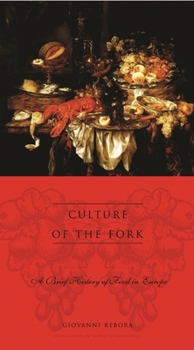Culture of the Fork: A Brief History of Everyday Food and Haute Cuisine in Europe
(Part of the Arts and Traditions of the Table: Perspectives on Culinary History Series)
We know where he went, what he wrote, and even what he wore, but what in the world did Christopher Columbus eat? The Renaissance and the age of discovery introduced Europeans to exotic cultures, mores, manners, and ideas. Along with the cross-cultural exchange of Old and New World, East and West, came new foodstuffs, preparations, and flavors. That kitchen revolution led to the development of new utensils and table manners. Some of the impact is...
Format:Hardcover
Language:English
ISBN:0231121504
ISBN13:9780231121507
Release Date:November 2001
Publisher:Columbia University Press
Length:224 Pages
Weight:0.85 lbs.
Dimensions:0.8" x 5.3" x 9.3"
Customer Reviews
1 rating
Let them use forks
Published by Thriftbooks.com User , 20 years ago
Constantinople went Muslim on May 29, 1453. America went Spanish on October 12, 1492. Months before, Spaniards fired the last Islamic king. All three happenings jump-started new food trends.Another jump-start was new money- and power-holders. Bankers, mercenary captains, and merchants governed 15th-century Italy. They weren't from the traditionally Germanic nobility. They were open to new ways of doing things.So too were glass- and tablecloth-makers, potters and silversmiths. Making cooking- and dinner-ware brought money and power. It was gold and silver for the rich, pewter and fine pottery for the middle class, and ceramics and wood for the poor.Discoveries, politics, trade agreements and war also changed what people ate. Tradesmen swapped customs and ideas while dealing in goods and money. With enough savings, trades and palace cooks opened carry-outs, drinking houses, inns and taverns. There, the public found out the latest too.One thing new was the CULTURE OF THE FORK. It came into use with eating pasta. A cookbook from medieval Naples urged eating lasagna with a single-pronged wooden utensil. Known as punteruolo, it led into the fork.In Portuguese, when a poor man eats a chicken one of the two's sick. Selling the chicken meant the peasant could ape luxury-buying and use forks. This was possible when larger amounts of foods, such as spices, became easier to get. Prices went down. The elite stopped buying. Instead, the wealthy French switched to countryside herbs. Wealthy Spaniards took up hot chili peppers, new from America. In the Piedmont and Tuscany, cloves and pepper, respectively, went from elite to peasant use.Giovanni Rebora says that the subject needs more looking into. For example, are hunger, boring food and alcoholism recent problems? Other than rare famines, the poor had the basics. They generally didn't have luxuries. But the wealthy gave the poor good drinking and eating, on Carnival, Christmas, Easter, local saints' days, New Year and seasonal festivals. So, according to the author, hunger back then was nothing like those suffering concentration camps, gulags and slums in the 20th century.




